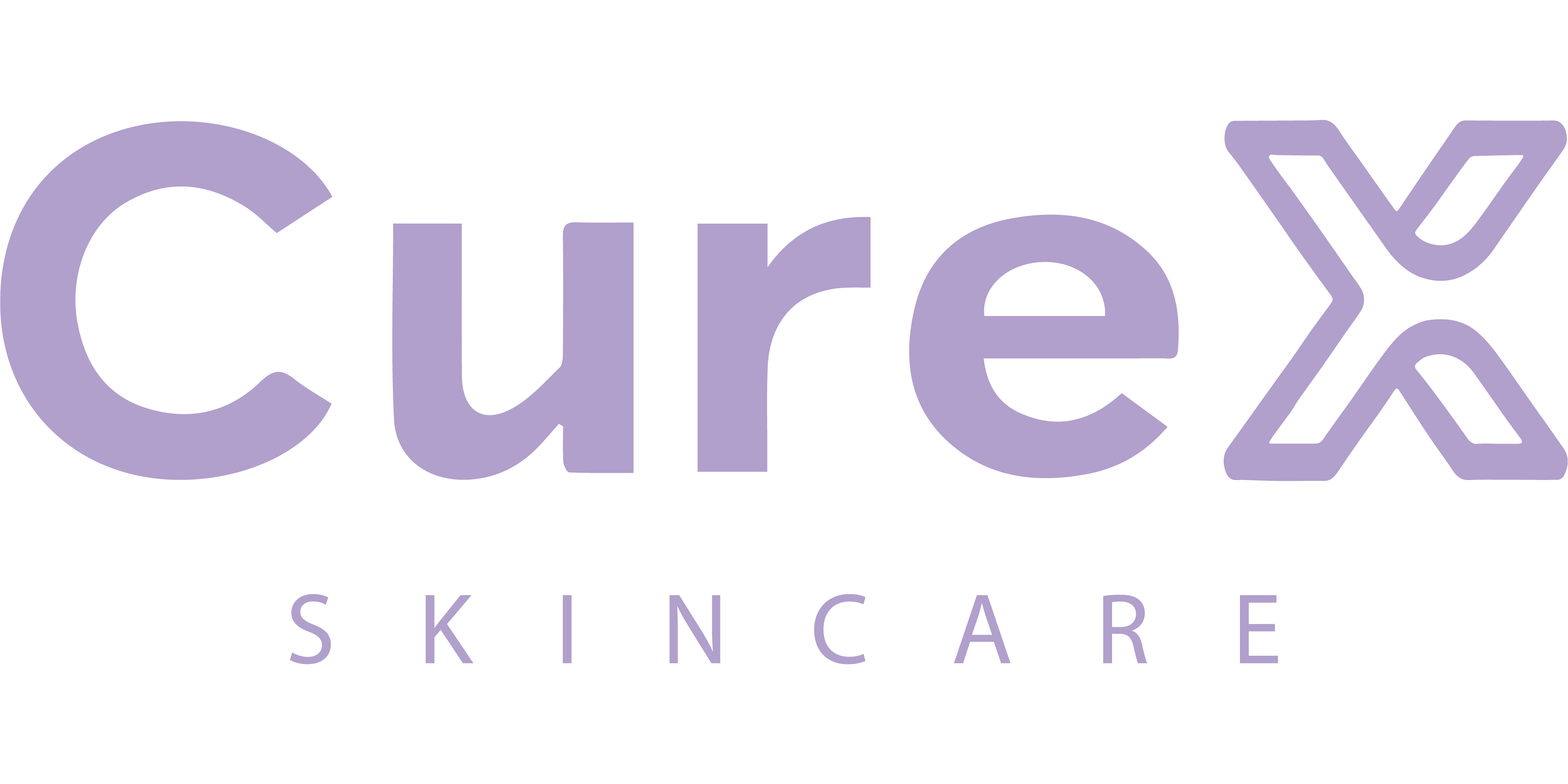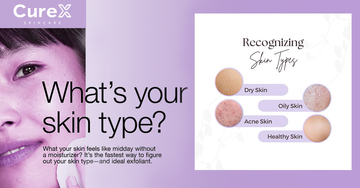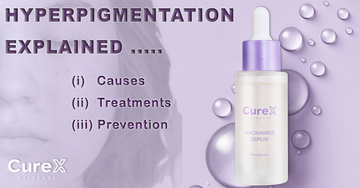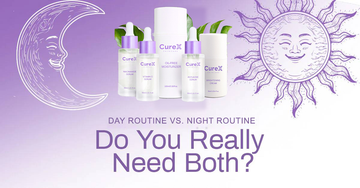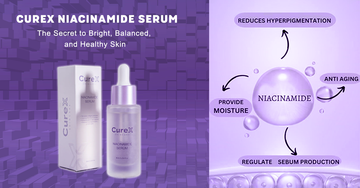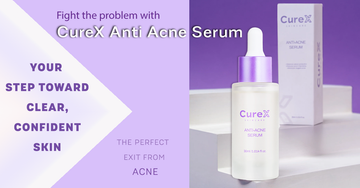A Complete Guide to Skin Types and Skincare
Why Knowing Your Skin Type Matters
Every person’s skin is unique, but dermatologists generally classify it into five main types: normal, oily, dry, combination, and sensitive. Identifying your skin type is the first step toward building the best skincare routine. Using products that don’t suit your type can lead to breakouts, irritation, or dryness. This guide explains how to identify your skin type and recommends suitable products such as CureX vitamin C serum, Curex niacinamide serum, and a Curex Oil free moisturizer.
Normal Skin – Balanced and Low-Maintenance
Normal skin is considered the most balanced type, with a smooth and even tone that isn’t too oily or too dry. People with normal skin usually have few blemishes, minimal sensitivity, and small, barely visible pores. Maintaining normal skin is straightforward: use a gentle cleanser, a lightweight hydrating moisturizer, and daily sunscreen for face to prevent premature aging. While normal skin doesn’t require targeted treatments, an antioxidant CureX vitamin C serum can help maintain brightness and a youthful glow.
Oily Skin – Shine and Enlarged Pores
Oily skin produces excess sebum, particularly in the T-zone (forehead, nose, and chin). It often shows enlarged pores, frequent acne, blackheads, and makeup that can slide off. For an effective oily skin care routine, use an oil-control or foaming cleanser, choose Curex oil-free, non-comedogenic moisturizer, and exfoliate gently two to three times per week. Curex Niacinamide Serum can help improve your oily skin.
Acne-Prone Oily Skin – Breakouts and Sensitivity
Acne-prone skin is a common subtype of oily skin and is often more sensitive, with frequent pimples, whiteheads, blackheads, inflammation, and redness. Avoid harsh scrubs that can irritate acne; instead, use gentle, soothing treatments and lightweight moisturizers. For targeted acne treatment, consider Curex Anti-acne serum infused with Mandelic Acid with calming actives that fight acne-causing bacteria, calm inflammation, and prevent new breakouts.
Dry Skin – Flaky and Rough
Dry skin often feels tight, rough, and flaky, with dullness and fine lines that appear more visible due to dehydration. To treat dry skin, use a hydrating, cream-based cleanser and a moisturizer containing hyaluronic acid or ceramides. Avoid hot water when washing your face and layer products to lock in moisture. A Curex Oil free Moisturizer for dry skin can help brighten the complexion, reduce pigmentation, and support hydration.
Combination Skin – Both Oily and Dry
Combination skin features an oily T-zone with dry or normal cheeks, which may lead to acne in oily areas and flakiness on dry patches. Balance is key: use a gentle, balancing cleanser, apply gel moisturizers on oily areas and richer creams on dry patches, and exfoliate once or twice weekly. For both oily and dry skin yoiu can use multitasking Curex Niacinamide serum.
Sensitive Skin – Easily Irritated
Sensitive skin is more reactive and may show redness, itching, or burning after using new products or when exposed to weather and pollution. It can be associated with conditions such as eczema, rosacea, or allergies. For sensitive skin, choose fragrance-free and hypoallergenic products, avoid alcohol-based toners and harsh scrubs, and always patch-test new items. Calming ingredients like aloe vera and ceramides can help soothe irritation and rebuild the skin barrier.
How to Identify Your Skin Type at Home
If you’re unsure of your skin type, try this simple at-home test: wash your face with a gentle cleanser and leave it bare—without moisturizer or serum—for one to two hours. Then observe how your skin behaves. If it looks shiny all over, it’s likely oily skin. If it feels tight and flaky, you probably have dry skin. A shiny T-zone with dry cheeks indicates combination skin, while an even and balanced appearance suggests normal skin. If you experience redness, itching, or irritation, your skin may be sensitive. This quick method is an easy way to identify your skin type without professional testing.
FAQs
Q1. Why is it important to know your skin type?
Knowing your skin type helps you choose the right products, such as the best moisturizer for dry skin, acne face wash, or even a gentle cleansing milk. Using products that don’t match your skin can lead to irritation, breakouts, or dryness. Identifying your type ensures your skincare routine works effectively.
Q2. What is considered normal skin?
Normal skin is balanced—not too oily or too dry—and has small, invisible pores. It usually requires minimal care, but using a lightweight Oil Free moisturizer, sunscreen for dry skin, or even a mild rice face wash can help maintain a healthy glow.
Q3. How can I manage oily skin effectively?
Oily skin benefits from oil-control cleansers like Curex Brightening Foaming face wash or medicated face wash. A non-comedogenic moisturizer and gentle exfoliation 2–3 times a week help control excess oil. Curex Niacinamide and ingrediants like salycylic acid reduce shine and prevent clogged pores.
Q4. What is the difference between oily skin and acne-prone skin?
While oily skin produces excess sebum, acne-prone skin is more sensitive and experiences frequent breakouts. For acne-prone types, a medicated acne face wash, acne cream pair, or retinol cream works better than regular oily skin products. These control bacteria, reduce inflammation, and prevent new pimples.
Q5. How should I take care of dry skin?
Dry skin needs deep hydration with cream-based cleansers and the Curex Oil free Moisturizer which is the best moisturizer for dry skin in Pakistan. Adding Cicaplas cream, a hydrating facial kit, or a nourishing Curex Brightening cream can improve skin texture. For daytime, apply sunscreen for dry skin or a tinted sunblock to prevent sun damage.
Final Thoughts
The five main skin types—normal, oily, dry, combination, and sensitive—each come with their own challenges and needs. By understanding your skin type, you can choose the right cleansers, moisturizers, serums, and sunscreen to build the best skincare routine. Skincare isn’t just about beauty; it’s about creating a routine that supports healthy, radiant skin for the long term.
